University Counselling Practice: Role Play Reflection Essay
VerifiedAdded on 2022/08/21
|7
|2014
|105
Report
AI Summary
This reflection essay analyzes a counselling role play, focusing on the application of Egan's helping model and micro-skills. The student, playing the role of a counsellor, attempts to understand the client's (Mary's) problems, stemming from marital issues and unhappiness. The essay details the use of the three stages of Egan's model: exploration, challenging existing views, and action plan. It discusses the importance of active listening, rapport building, and asking relevant questions. The student reflects on their performance, highlighting strengths like attentiveness and appropriate questioning, while also identifying areas for improvement, such as confronting the client more directly and ensuring confidentiality. The essay concludes with suggestions for the client, including improving communication skills and finding hobbies to alleviate feelings of unhappiness. References to relevant literature are also included.
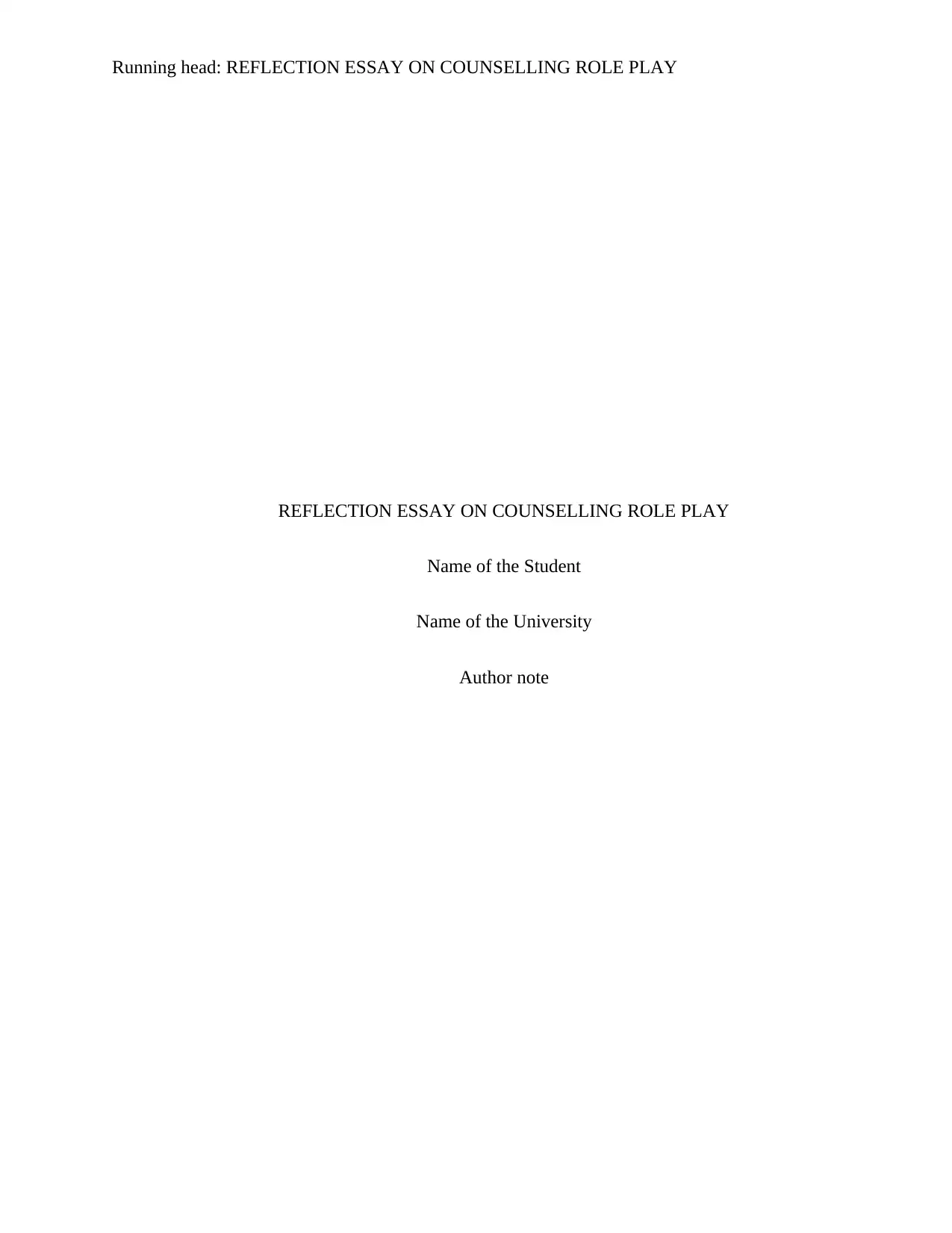
Running head: REFLECTION ESSAY ON COUNSELLING ROLE PLAY
REFLECTION ESSAY ON COUNSELLING ROLE PLAY
Name of the Student
Name of the University
Author note
REFLECTION ESSAY ON COUNSELLING ROLE PLAY
Name of the Student
Name of the University
Author note
Paraphrase This Document
Need a fresh take? Get an instant paraphrase of this document with our AI Paraphraser
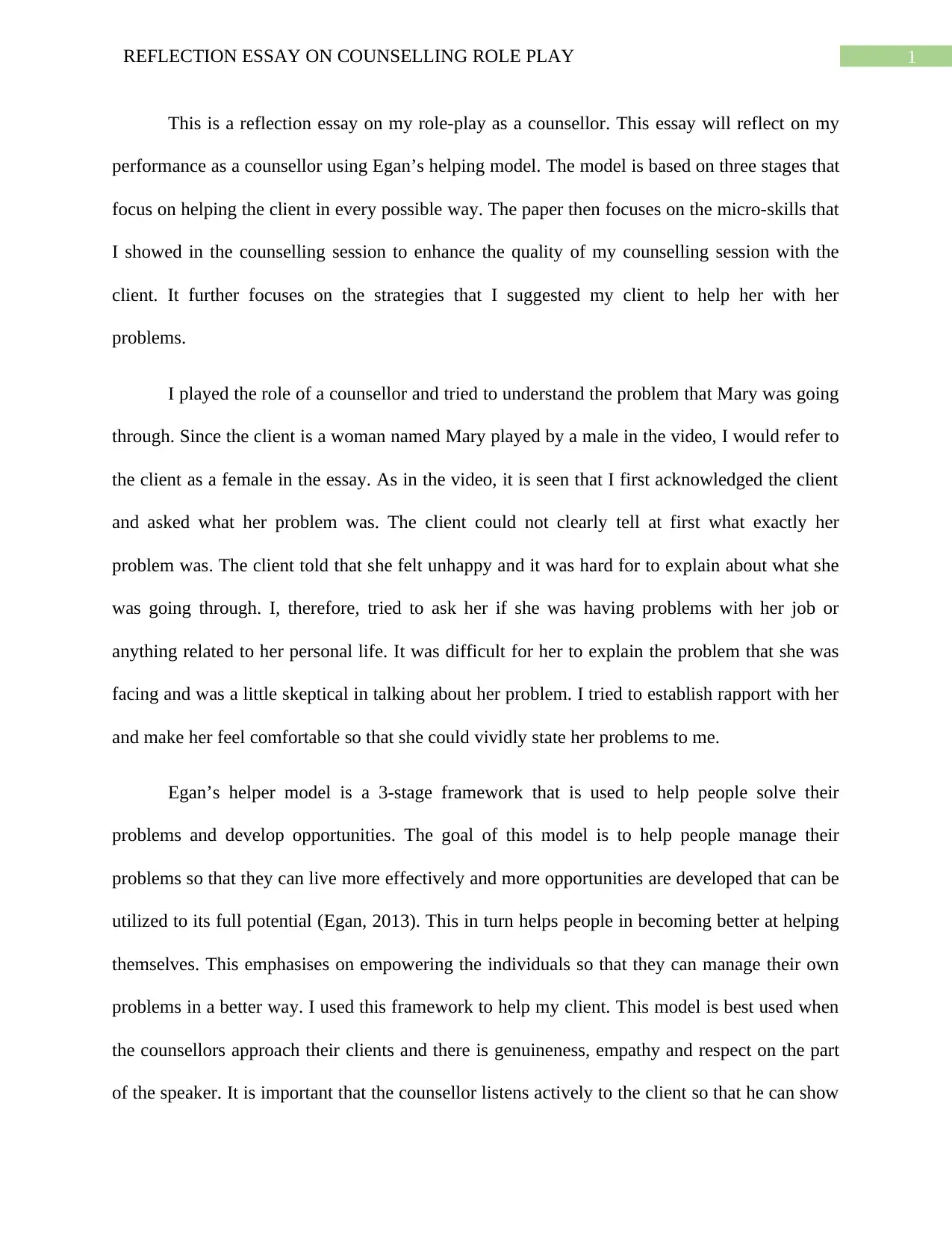
1REFLECTION ESSAY ON COUNSELLING ROLE PLAY
This is a reflection essay on my role-play as a counsellor. This essay will reflect on my
performance as a counsellor using Egan’s helping model. The model is based on three stages that
focus on helping the client in every possible way. The paper then focuses on the micro-skills that
I showed in the counselling session to enhance the quality of my counselling session with the
client. It further focuses on the strategies that I suggested my client to help her with her
problems.
I played the role of a counsellor and tried to understand the problem that Mary was going
through. Since the client is a woman named Mary played by a male in the video, I would refer to
the client as a female in the essay. As in the video, it is seen that I first acknowledged the client
and asked what her problem was. The client could not clearly tell at first what exactly her
problem was. The client told that she felt unhappy and it was hard for to explain about what she
was going through. I, therefore, tried to ask her if she was having problems with her job or
anything related to her personal life. It was difficult for her to explain the problem that she was
facing and was a little skeptical in talking about her problem. I tried to establish rapport with her
and make her feel comfortable so that she could vividly state her problems to me.
Egan’s helper model is a 3-stage framework that is used to help people solve their
problems and develop opportunities. The goal of this model is to help people manage their
problems so that they can live more effectively and more opportunities are developed that can be
utilized to its full potential (Egan, 2013). This in turn helps people in becoming better at helping
themselves. This emphasises on empowering the individuals so that they can manage their own
problems in a better way. I used this framework to help my client. This model is best used when
the counsellors approach their clients and there is genuineness, empathy and respect on the part
of the speaker. It is important that the counsellor listens actively to the client so that he can show
This is a reflection essay on my role-play as a counsellor. This essay will reflect on my
performance as a counsellor using Egan’s helping model. The model is based on three stages that
focus on helping the client in every possible way. The paper then focuses on the micro-skills that
I showed in the counselling session to enhance the quality of my counselling session with the
client. It further focuses on the strategies that I suggested my client to help her with her
problems.
I played the role of a counsellor and tried to understand the problem that Mary was going
through. Since the client is a woman named Mary played by a male in the video, I would refer to
the client as a female in the essay. As in the video, it is seen that I first acknowledged the client
and asked what her problem was. The client could not clearly tell at first what exactly her
problem was. The client told that she felt unhappy and it was hard for to explain about what she
was going through. I, therefore, tried to ask her if she was having problems with her job or
anything related to her personal life. It was difficult for her to explain the problem that she was
facing and was a little skeptical in talking about her problem. I tried to establish rapport with her
and make her feel comfortable so that she could vividly state her problems to me.
Egan’s helper model is a 3-stage framework that is used to help people solve their
problems and develop opportunities. The goal of this model is to help people manage their
problems so that they can live more effectively and more opportunities are developed that can be
utilized to its full potential (Egan, 2013). This in turn helps people in becoming better at helping
themselves. This emphasises on empowering the individuals so that they can manage their own
problems in a better way. I used this framework to help my client. This model is best used when
the counsellors approach their clients and there is genuineness, empathy and respect on the part
of the speaker. It is important that the counsellor listens actively to the client so that he can show
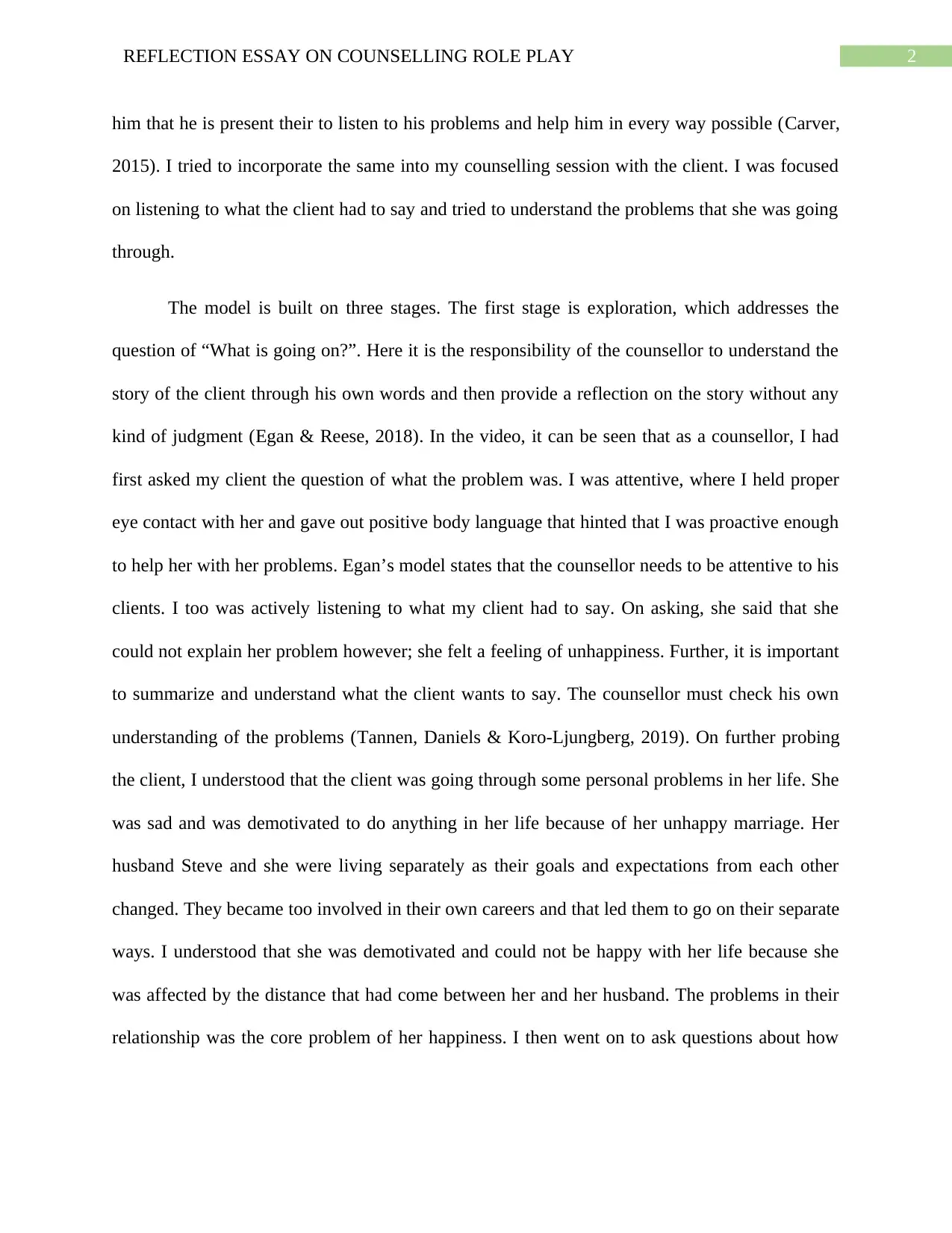
2REFLECTION ESSAY ON COUNSELLING ROLE PLAY
him that he is present their to listen to his problems and help him in every way possible (Carver,
2015). I tried to incorporate the same into my counselling session with the client. I was focused
on listening to what the client had to say and tried to understand the problems that she was going
through.
The model is built on three stages. The first stage is exploration, which addresses the
question of “What is going on?”. Here it is the responsibility of the counsellor to understand the
story of the client through his own words and then provide a reflection on the story without any
kind of judgment (Egan & Reese, 2018). In the video, it can be seen that as a counsellor, I had
first asked my client the question of what the problem was. I was attentive, where I held proper
eye contact with her and gave out positive body language that hinted that I was proactive enough
to help her with her problems. Egan’s model states that the counsellor needs to be attentive to his
clients. I too was actively listening to what my client had to say. On asking, she said that she
could not explain her problem however; she felt a feeling of unhappiness. Further, it is important
to summarize and understand what the client wants to say. The counsellor must check his own
understanding of the problems (Tannen, Daniels & Koro-Ljungberg, 2019). On further probing
the client, I understood that the client was going through some personal problems in her life. She
was sad and was demotivated to do anything in her life because of her unhappy marriage. Her
husband Steve and she were living separately as their goals and expectations from each other
changed. They became too involved in their own careers and that led them to go on their separate
ways. I understood that she was demotivated and could not be happy with her life because she
was affected by the distance that had come between her and her husband. The problems in their
relationship was the core problem of her happiness. I then went on to ask questions about how
him that he is present their to listen to his problems and help him in every way possible (Carver,
2015). I tried to incorporate the same into my counselling session with the client. I was focused
on listening to what the client had to say and tried to understand the problems that she was going
through.
The model is built on three stages. The first stage is exploration, which addresses the
question of “What is going on?”. Here it is the responsibility of the counsellor to understand the
story of the client through his own words and then provide a reflection on the story without any
kind of judgment (Egan & Reese, 2018). In the video, it can be seen that as a counsellor, I had
first asked my client the question of what the problem was. I was attentive, where I held proper
eye contact with her and gave out positive body language that hinted that I was proactive enough
to help her with her problems. Egan’s model states that the counsellor needs to be attentive to his
clients. I too was actively listening to what my client had to say. On asking, she said that she
could not explain her problem however; she felt a feeling of unhappiness. Further, it is important
to summarize and understand what the client wants to say. The counsellor must check his own
understanding of the problems (Tannen, Daniels & Koro-Ljungberg, 2019). On further probing
the client, I understood that the client was going through some personal problems in her life. She
was sad and was demotivated to do anything in her life because of her unhappy marriage. Her
husband Steve and she were living separately as their goals and expectations from each other
changed. They became too involved in their own careers and that led them to go on their separate
ways. I understood that she was demotivated and could not be happy with her life because she
was affected by the distance that had come between her and her husband. The problems in their
relationship was the core problem of her happiness. I then went on to ask questions about how
⊘ This is a preview!⊘
Do you want full access?
Subscribe today to unlock all pages.

Trusted by 1+ million students worldwide
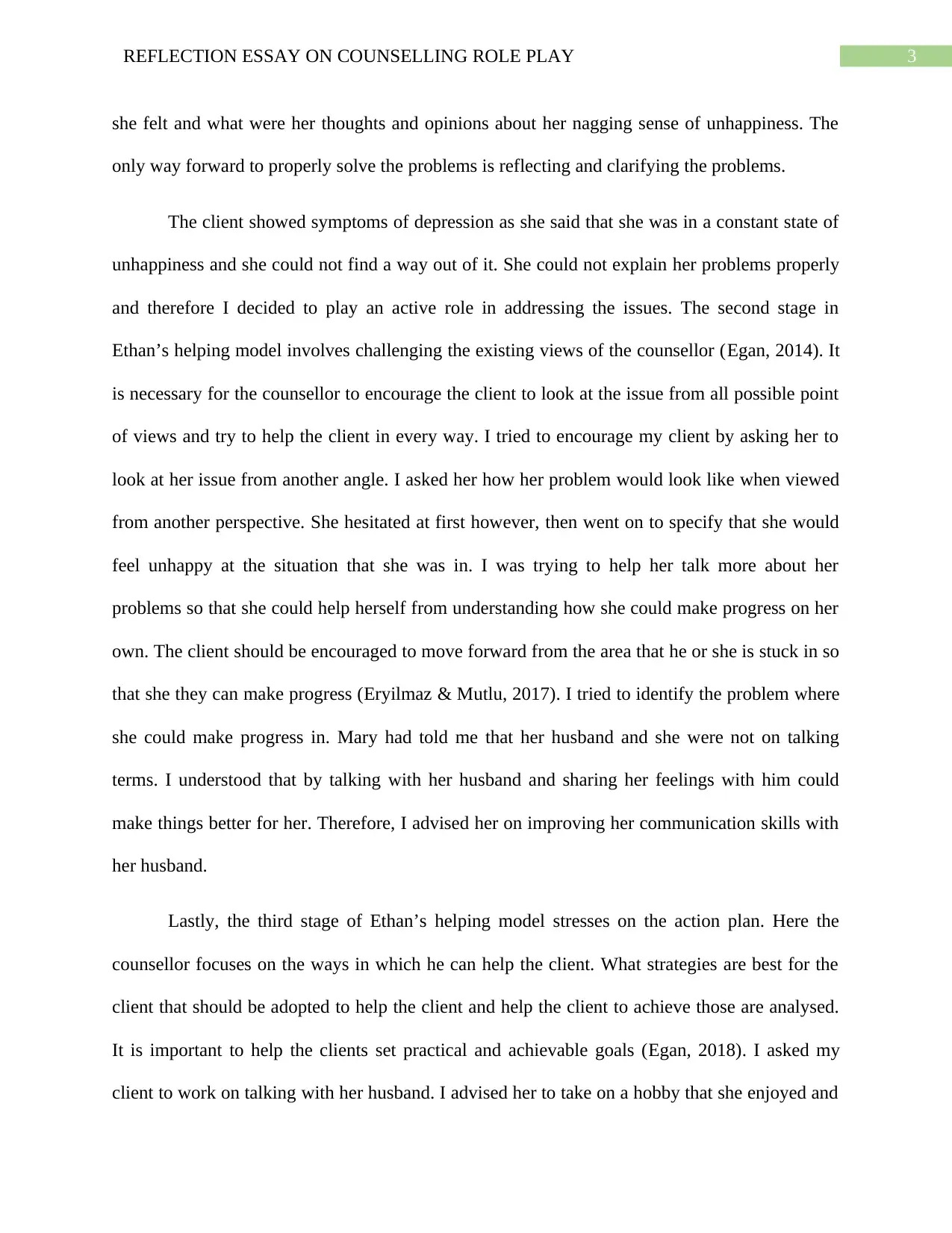
3REFLECTION ESSAY ON COUNSELLING ROLE PLAY
she felt and what were her thoughts and opinions about her nagging sense of unhappiness. The
only way forward to properly solve the problems is reflecting and clarifying the problems.
The client showed symptoms of depression as she said that she was in a constant state of
unhappiness and she could not find a way out of it. She could not explain her problems properly
and therefore I decided to play an active role in addressing the issues. The second stage in
Ethan’s helping model involves challenging the existing views of the counsellor (Egan, 2014). It
is necessary for the counsellor to encourage the client to look at the issue from all possible point
of views and try to help the client in every way. I tried to encourage my client by asking her to
look at her issue from another angle. I asked her how her problem would look like when viewed
from another perspective. She hesitated at first however, then went on to specify that she would
feel unhappy at the situation that she was in. I was trying to help her talk more about her
problems so that she could help herself from understanding how she could make progress on her
own. The client should be encouraged to move forward from the area that he or she is stuck in so
that she they can make progress (Eryilmaz & Mutlu, 2017). I tried to identify the problem where
she could make progress in. Mary had told me that her husband and she were not on talking
terms. I understood that by talking with her husband and sharing her feelings with him could
make things better for her. Therefore, I advised her on improving her communication skills with
her husband.
Lastly, the third stage of Ethan’s helping model stresses on the action plan. Here the
counsellor focuses on the ways in which he can help the client. What strategies are best for the
client that should be adopted to help the client and help the client to achieve those are analysed.
It is important to help the clients set practical and achievable goals (Egan, 2018). I asked my
client to work on talking with her husband. I advised her to take on a hobby that she enjoyed and
she felt and what were her thoughts and opinions about her nagging sense of unhappiness. The
only way forward to properly solve the problems is reflecting and clarifying the problems.
The client showed symptoms of depression as she said that she was in a constant state of
unhappiness and she could not find a way out of it. She could not explain her problems properly
and therefore I decided to play an active role in addressing the issues. The second stage in
Ethan’s helping model involves challenging the existing views of the counsellor (Egan, 2014). It
is necessary for the counsellor to encourage the client to look at the issue from all possible point
of views and try to help the client in every way. I tried to encourage my client by asking her to
look at her issue from another angle. I asked her how her problem would look like when viewed
from another perspective. She hesitated at first however, then went on to specify that she would
feel unhappy at the situation that she was in. I was trying to help her talk more about her
problems so that she could help herself from understanding how she could make progress on her
own. The client should be encouraged to move forward from the area that he or she is stuck in so
that she they can make progress (Eryilmaz & Mutlu, 2017). I tried to identify the problem where
she could make progress in. Mary had told me that her husband and she were not on talking
terms. I understood that by talking with her husband and sharing her feelings with him could
make things better for her. Therefore, I advised her on improving her communication skills with
her husband.
Lastly, the third stage of Ethan’s helping model stresses on the action plan. Here the
counsellor focuses on the ways in which he can help the client. What strategies are best for the
client that should be adopted to help the client and help the client to achieve those are analysed.
It is important to help the clients set practical and achievable goals (Egan, 2018). I asked my
client to work on talking with her husband. I advised her to take on a hobby that she enjoyed and
Paraphrase This Document
Need a fresh take? Get an instant paraphrase of this document with our AI Paraphraser
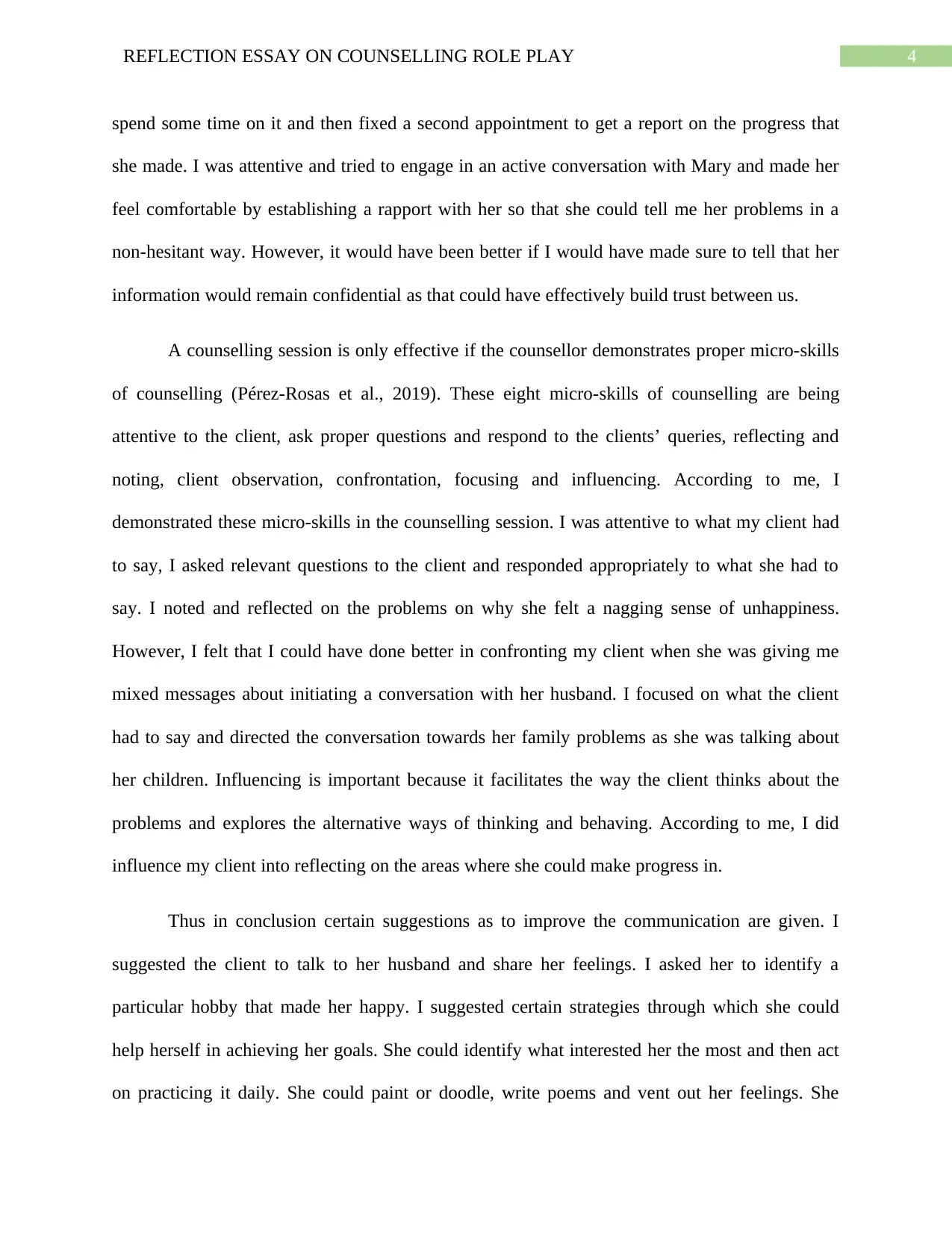
4REFLECTION ESSAY ON COUNSELLING ROLE PLAY
spend some time on it and then fixed a second appointment to get a report on the progress that
she made. I was attentive and tried to engage in an active conversation with Mary and made her
feel comfortable by establishing a rapport with her so that she could tell me her problems in a
non-hesitant way. However, it would have been better if I would have made sure to tell that her
information would remain confidential as that could have effectively build trust between us.
A counselling session is only effective if the counsellor demonstrates proper micro-skills
of counselling (Pérez-Rosas et al., 2019). These eight micro-skills of counselling are being
attentive to the client, ask proper questions and respond to the clients’ queries, reflecting and
noting, client observation, confrontation, focusing and influencing. According to me, I
demonstrated these micro-skills in the counselling session. I was attentive to what my client had
to say, I asked relevant questions to the client and responded appropriately to what she had to
say. I noted and reflected on the problems on why she felt a nagging sense of unhappiness.
However, I felt that I could have done better in confronting my client when she was giving me
mixed messages about initiating a conversation with her husband. I focused on what the client
had to say and directed the conversation towards her family problems as she was talking about
her children. Influencing is important because it facilitates the way the client thinks about the
problems and explores the alternative ways of thinking and behaving. According to me, I did
influence my client into reflecting on the areas where she could make progress in.
Thus in conclusion certain suggestions as to improve the communication are given. I
suggested the client to talk to her husband and share her feelings. I asked her to identify a
particular hobby that made her happy. I suggested certain strategies through which she could
help herself in achieving her goals. She could identify what interested her the most and then act
on practicing it daily. She could paint or doodle, write poems and vent out her feelings. She
spend some time on it and then fixed a second appointment to get a report on the progress that
she made. I was attentive and tried to engage in an active conversation with Mary and made her
feel comfortable by establishing a rapport with her so that she could tell me her problems in a
non-hesitant way. However, it would have been better if I would have made sure to tell that her
information would remain confidential as that could have effectively build trust between us.
A counselling session is only effective if the counsellor demonstrates proper micro-skills
of counselling (Pérez-Rosas et al., 2019). These eight micro-skills of counselling are being
attentive to the client, ask proper questions and respond to the clients’ queries, reflecting and
noting, client observation, confrontation, focusing and influencing. According to me, I
demonstrated these micro-skills in the counselling session. I was attentive to what my client had
to say, I asked relevant questions to the client and responded appropriately to what she had to
say. I noted and reflected on the problems on why she felt a nagging sense of unhappiness.
However, I felt that I could have done better in confronting my client when she was giving me
mixed messages about initiating a conversation with her husband. I focused on what the client
had to say and directed the conversation towards her family problems as she was talking about
her children. Influencing is important because it facilitates the way the client thinks about the
problems and explores the alternative ways of thinking and behaving. According to me, I did
influence my client into reflecting on the areas where she could make progress in.
Thus in conclusion certain suggestions as to improve the communication are given. I
suggested the client to talk to her husband and share her feelings. I asked her to identify a
particular hobby that made her happy. I suggested certain strategies through which she could
help herself in achieving her goals. She could identify what interested her the most and then act
on practicing it daily. She could paint or doodle, write poems and vent out her feelings. She
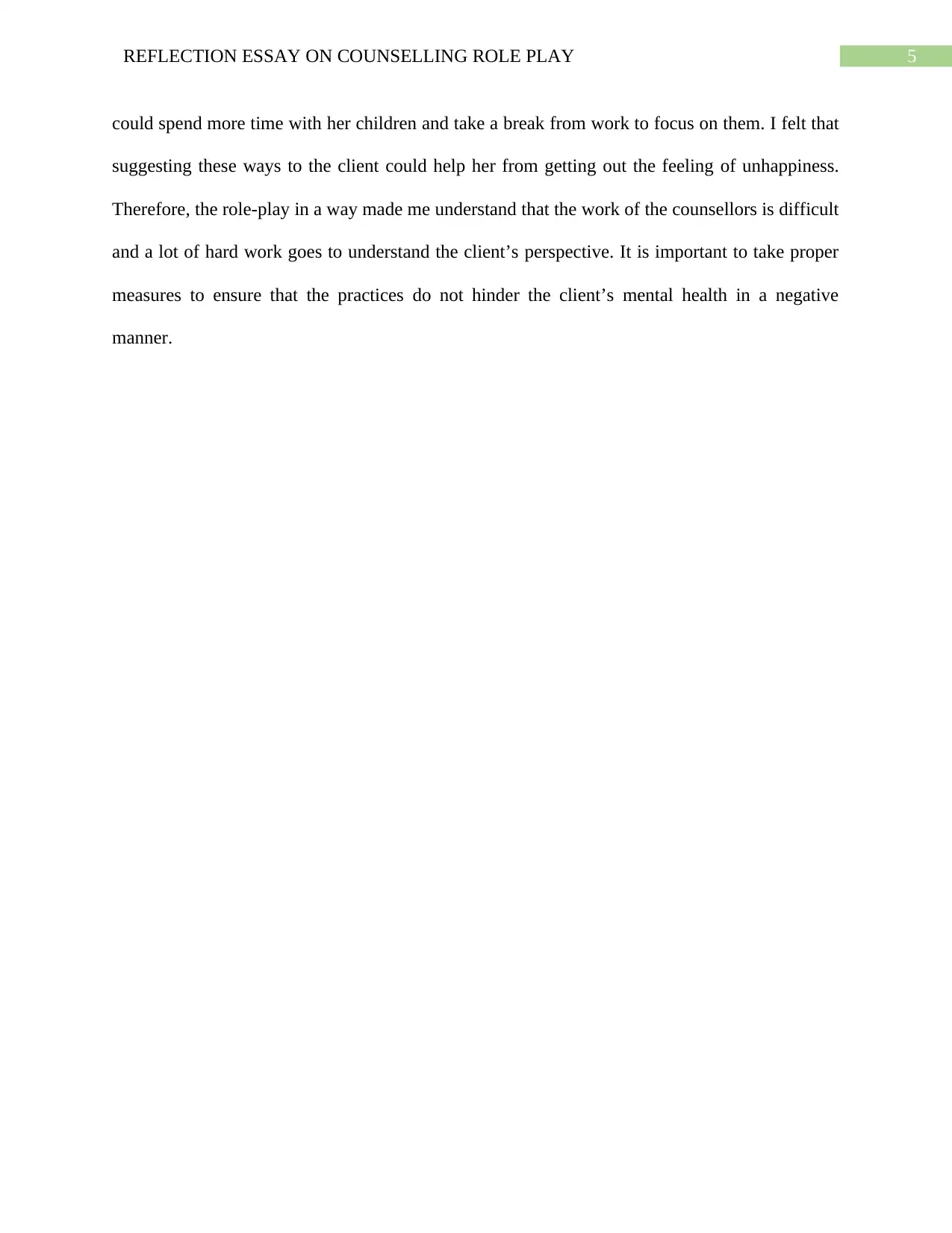
5REFLECTION ESSAY ON COUNSELLING ROLE PLAY
could spend more time with her children and take a break from work to focus on them. I felt that
suggesting these ways to the client could help her from getting out the feeling of unhappiness.
Therefore, the role-play in a way made me understand that the work of the counsellors is difficult
and a lot of hard work goes to understand the client’s perspective. It is important to take proper
measures to ensure that the practices do not hinder the client’s mental health in a negative
manner.
could spend more time with her children and take a break from work to focus on them. I felt that
suggesting these ways to the client could help her from getting out the feeling of unhappiness.
Therefore, the role-play in a way made me understand that the work of the counsellors is difficult
and a lot of hard work goes to understand the client’s perspective. It is important to take proper
measures to ensure that the practices do not hinder the client’s mental health in a negative
manner.
⊘ This is a preview!⊘
Do you want full access?
Subscribe today to unlock all pages.

Trusted by 1+ million students worldwide
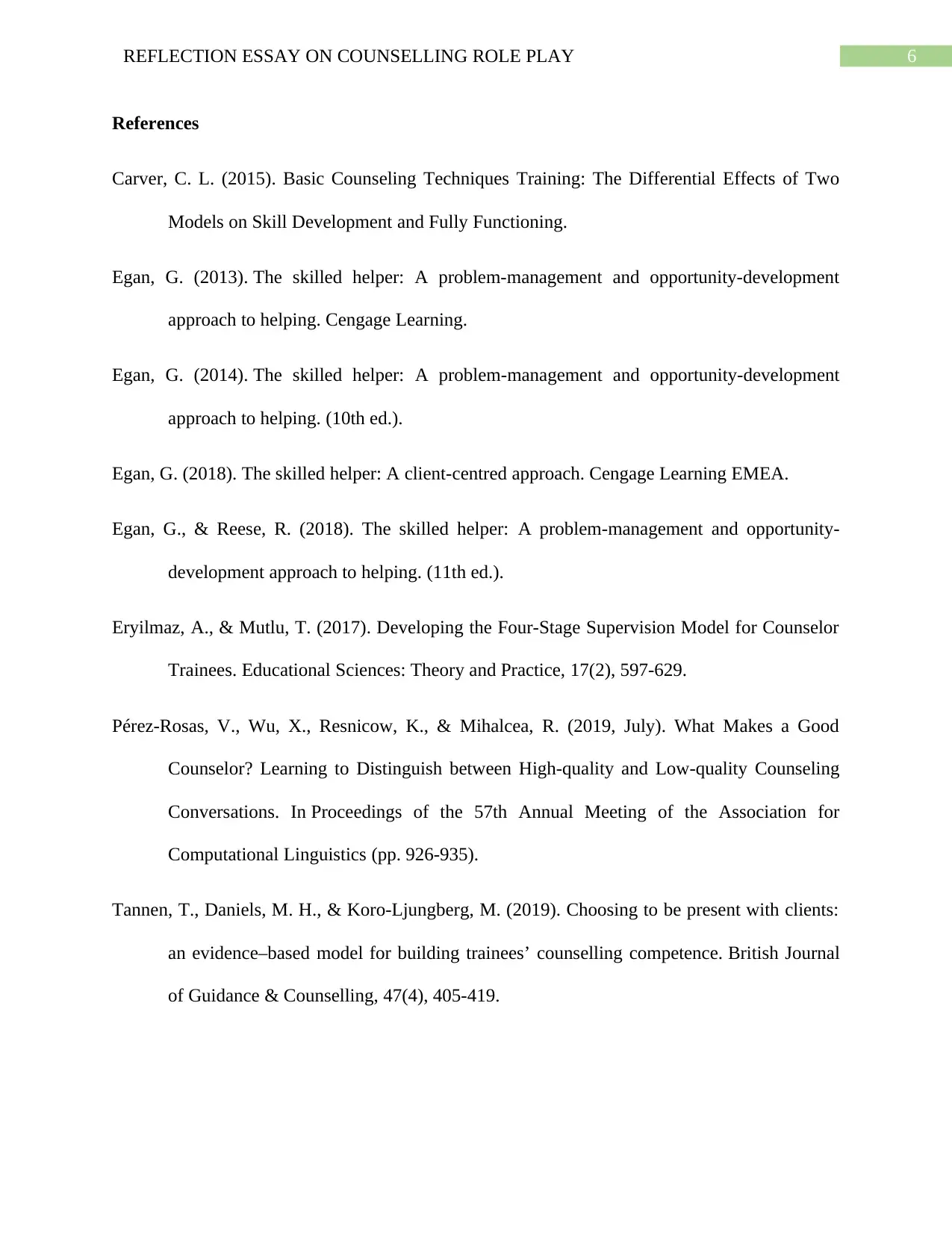
6REFLECTION ESSAY ON COUNSELLING ROLE PLAY
References
Carver, C. L. (2015). Basic Counseling Techniques Training: The Differential Effects of Two
Models on Skill Development and Fully Functioning.
Egan, G. (2013). The skilled helper: A problem-management and opportunity-development
approach to helping. Cengage Learning.
Egan, G. (2014). The skilled helper: A problem-management and opportunity-development
approach to helping. (10th ed.).
Egan, G. (2018). The skilled helper: A client-centred approach. Cengage Learning EMEA.
Egan, G., & Reese, R. (2018). The skilled helper: A problem-management and opportunity-
development approach to helping. (11th ed.).
Eryilmaz, A., & Mutlu, T. (2017). Developing the Four-Stage Supervision Model for Counselor
Trainees. Educational Sciences: Theory and Practice, 17(2), 597-629.
Pérez-Rosas, V., Wu, X., Resnicow, K., & Mihalcea, R. (2019, July). What Makes a Good
Counselor? Learning to Distinguish between High-quality and Low-quality Counseling
Conversations. In Proceedings of the 57th Annual Meeting of the Association for
Computational Linguistics (pp. 926-935).
Tannen, T., Daniels, M. H., & Koro-Ljungberg, M. (2019). Choosing to be present with clients:
an evidence–based model for building trainees’ counselling competence. British Journal
of Guidance & Counselling, 47(4), 405-419.
References
Carver, C. L. (2015). Basic Counseling Techniques Training: The Differential Effects of Two
Models on Skill Development and Fully Functioning.
Egan, G. (2013). The skilled helper: A problem-management and opportunity-development
approach to helping. Cengage Learning.
Egan, G. (2014). The skilled helper: A problem-management and opportunity-development
approach to helping. (10th ed.).
Egan, G. (2018). The skilled helper: A client-centred approach. Cengage Learning EMEA.
Egan, G., & Reese, R. (2018). The skilled helper: A problem-management and opportunity-
development approach to helping. (11th ed.).
Eryilmaz, A., & Mutlu, T. (2017). Developing the Four-Stage Supervision Model for Counselor
Trainees. Educational Sciences: Theory and Practice, 17(2), 597-629.
Pérez-Rosas, V., Wu, X., Resnicow, K., & Mihalcea, R. (2019, July). What Makes a Good
Counselor? Learning to Distinguish between High-quality and Low-quality Counseling
Conversations. In Proceedings of the 57th Annual Meeting of the Association for
Computational Linguistics (pp. 926-935).
Tannen, T., Daniels, M. H., & Koro-Ljungberg, M. (2019). Choosing to be present with clients:
an evidence–based model for building trainees’ counselling competence. British Journal
of Guidance & Counselling, 47(4), 405-419.
1 out of 7
Related Documents
Your All-in-One AI-Powered Toolkit for Academic Success.
+13062052269
info@desklib.com
Available 24*7 on WhatsApp / Email
![[object Object]](/_next/static/media/star-bottom.7253800d.svg)
Unlock your academic potential
Copyright © 2020–2025 A2Z Services. All Rights Reserved. Developed and managed by ZUCOL.





